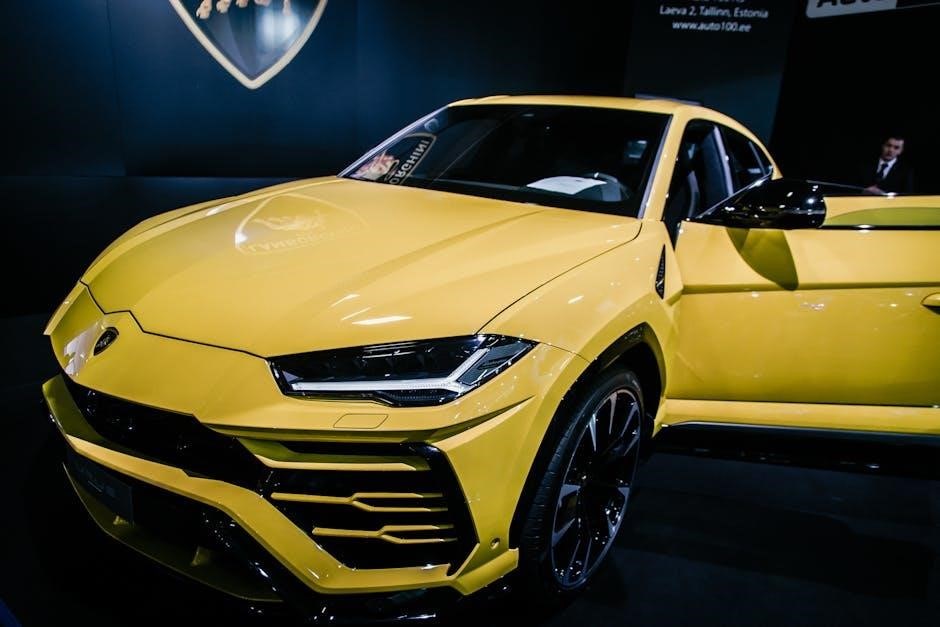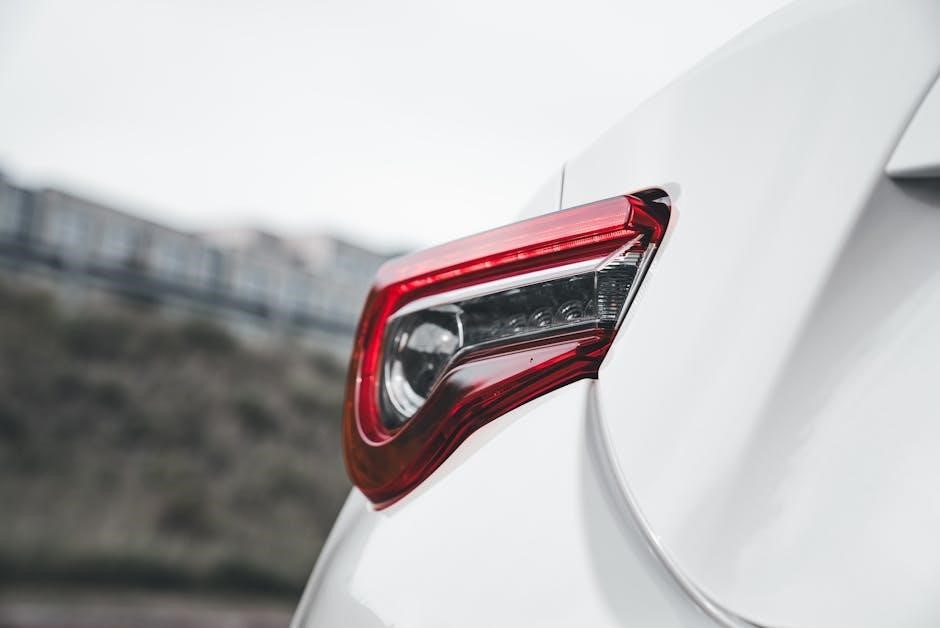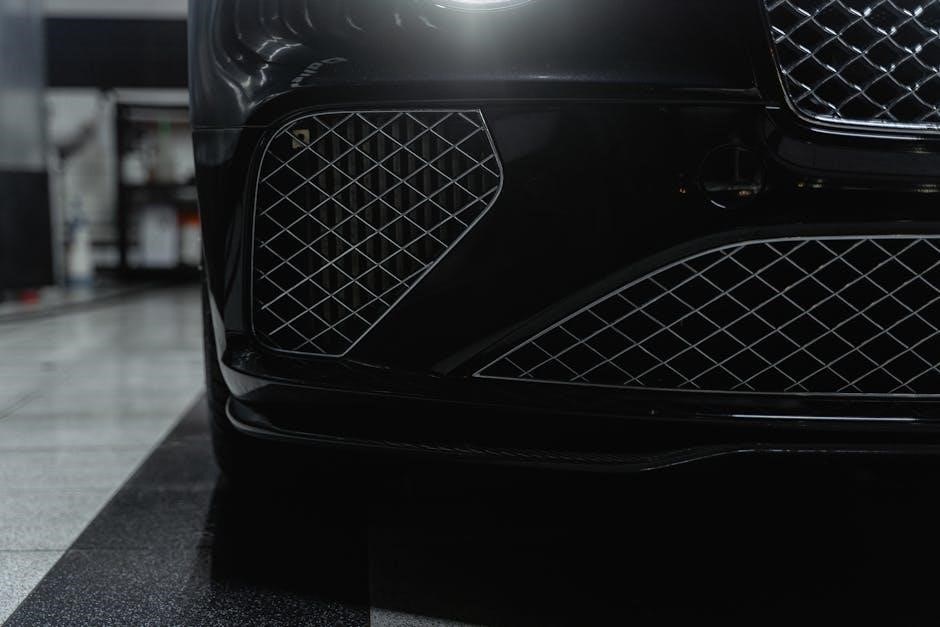
Car headlight bulbs are essential for visibility and safety, illuminating the road ahead. They come in types like halogen, LED, and xenon, each offering unique benefits. Brightness, lifespan, and vehicle compatibility are key factors to consider when selecting the right bulb for your car.
Types of Car Headlight Bulbs
Car headlight bulbs are available in halogen, LED, and xenon types, each offering distinct advantages in brightness, energy efficiency, and lifespan to suit various driving needs.
2.1. Halogen Bulbs
Halogen bulbs are the most common type of car headlight bulb. They use a tungsten filament in a halogen gas-filled bulb, which prolongs lifespan and maintains brightness. Known for their reliability and affordability, halogen bulbs are a popular choice for standard vehicles. They provide a warm, yellowish light and are easy to replace. However, they are less energy-efficient compared to LED or xenon bulbs and have a shorter lifespan. Despite these drawbacks, halogen bulbs remain widely used due to their cost-effectiveness and compatibility with most vehicles. They are a practical option for drivers seeking a balance between performance and budget.
2.2. LED Bulbs
LED bulbs are a modern and energy-efficient option for car headlights. They emit a bright, cool white light that enhances visibility on the road. Unlike halogen bulbs, LEDs use significantly less power and have a much longer lifespan, making them a cost-effective choice over time. Their instant-on capability provides faster illumination compared to xenon bulbs. However, not all LED bulbs are DOT approved, which is crucial for road legality. When selecting LED bulbs, ensure they meet safety standards to avoid issues with law enforcement. While they are more expensive upfront, their durability and efficiency make them a popular upgrade for drivers seeking improved performance and longevity. Always consult your vehicle’s manual or use an online bulb finder to ensure compatibility before purchasing LED bulbs for your car.
2.3. Xenon Bulbs
Xenon bulbs, also known as High-Intensity Discharge (HID) bulbs, are known for their bright, white light, which closely resembles natural daylight. They produce a higher lumen output compared to halogen bulbs, improving visibility on the road. Xenon bulbs are more energy-efficient and have a longer lifespan, typically lasting up to 2,000 hours or more. However, they require a ballast to operate, which can be prone to failure over time. Their light output is measured in color temperature, ranging from 4000K to 6000K, with higher values producing a bluer hue. While they provide excellent illumination, they take a few seconds to reach full brightness, unlike LEDs. Xenon bulbs are more expensive than halogen bulbs but are favored for their superior light quality and durability. Always ensure compatibility with your vehicle and check for DOT approval to avoid legal issues.
Factors to Consider When Choosing Headlight Bulbs
Brightness, lifespan, and vehicle compatibility are key factors. Ensure bulbs meet legal standards and suit your driving needs for optimal performance and safety on the road.
3.1. Brightness and Lumen Output
Brightness, measured in lumens, is a critical factor when selecting car headlight bulbs. Higher lumen output typically means greater visibility, but it’s important to balance brightness with proper light distribution to avoid blinding other drivers. Halogen bulbs generally range from 350 to 450 lumens, while LED and xenon bulbs can exceed 1,000 lumens, offering significantly more illumination. However, excessively bright bulbs can cause glare, which is why many LED bulbs are designed with specialized optics to focus light effectively. It’s also important to ensure that the bulb’s brightness complies with legal standards, as overly bright lights may not be road-legal. Always consider your driving habits and the environments you frequent—brighter bulbs are advantageous for nighttime or off-road driving, while lower lumens may suffice for city driving. Using an online bulb finder can help determine the ideal brightness for your vehicle.
3.2. Lifespan of the Bulb
The lifespan of a car headlight bulb varies significantly depending on the type and quality of the bulb. Halogen bulbs typically last between 400 and 600 hours, while LED bulbs can last up to 30,000 hours or more, making them a more durable option. Xenon bulbs generally fall in between, with an average lifespan of 2,000 to 4,000 hours. The lifespan is influenced by factors such as the bulb’s power consumption, operating conditions, and environmental factors like temperature and humidity. LEDs are known for their longevity due to their solid-state technology, which is less prone to failure compared to the filament-based design of halogen and xenon bulbs. Choosing a bulb with a longer lifespan can reduce the frequency of replacements, saving time and money. However, higher-quality, longer-lasting bulbs often come at a higher initial cost. Balancing lifespan and brightness is key to selecting the right bulb for your needs.
3.3. Vehicle Compatibility
Vehicle compatibility is a critical factor when selecting car headlight bulbs, as not all bulbs are suitable for every vehicle. The bulb must match the specific make, model, and year of your car to ensure proper fitment and functionality. Referencing the owner’s manual or using an online bulb finder tool can help determine the correct bulb type and size for your vehicle. Different cars may require varying wattage, base types, and bulb shapes, and using an incompatible bulb can lead to poor performance or even damage to the electrical system. Additionally, some modern vehicles have advanced lighting systems that require specialized bulbs designed for their unique configurations. Always verify compatibility before purchasing to ensure optimal performance, safety, and compliance with your vehicle’s specifications. Using the wrong bulb can result in reduced visibility, overheating, or legal issues if the lights do not meet road safety standards.

How to Select the Right Bulb for Your Vehicle
Selecting the right headlight bulb for your vehicle involves a combination of research and understanding your car’s specific needs. Start by consulting your owner’s manual or using an online bulb finder tool to determine the correct bulb type, size, and wattage for your vehicle. Consider the bulb’s purpose, such as low beam, high beam, or fog lights, as different functions may require different bulbs. Compare options based on brightness, lifespan, and energy efficiency, ensuring the bulb meets your driving habits and preferences. Check reviews and ratings to assess performance and reliability. Finally, verify that the bulb is compatible with your vehicle’s electrical system and meets safety standards. Proper selection ensures optimal visibility, safety, and compliance with road regulations. Always avoid using bulbs that do not match your vehicle’s specifications, as this can lead to reduced performance or potential electrical issues.

Installation and Replacement Guide
Access the back of the headlamp, locate the bulb holder, and gently twist it counterclockwise to remove. Replace with the new bulb, ensuring proper alignment, then twist clockwise to secure.
5.1. Step-by-Step Installation Process
To replace a car headlight bulb, start by turning off the engine and headlights. Open the hood and locate the headlight assembly. Remove the screws or clips holding the assembly in place. Gently pull the assembly forward to access the bulb holder. Twist the bulb holder counterclockwise to release it, then pull it out. Remove the old bulb by releasing the retaining ring or clips. Insert the new bulb, ensuring it’s securely seated and aligned properly. Reattach the bulb holder and twist it clockwise to lock it in place. Replace the headlight assembly and secure it with the screws or clips. Turn on the headlights to test the new bulb. Always consult your vehicle’s manual for specific instructions, as procedures may vary. Proper installation ensures safety and optimal performance.
5.2. Tools and Materials Needed
To replace a car headlight bulb, you’ll need specific tools and materials to ensure a smooth and safe process. Start with a screwdriver, preferably a Torx or Phillips head, depending on your vehicle’s requirements. Gloves and a clean, dry cloth are essential to handle the new bulb and prevent oil from your skin interfering with its performance. A towel or soft padding can protect the car’s paint and surfaces during disassembly. If your headlight assembly is held in place by clips or additional fasteners, pliers or a wrench may be necessary. For some vehicles, a trim removal tool can help access the headlight assembly without damaging the surrounding trim. Finally, have the replacement bulb ready, ensuring it’s the correct type and wattage for your vehicle. Refer to your owner’s manual for specific tools or materials recommended by the manufacturer.

Maintenance Tips for Car Headlight Bulbs
Regular maintenance ensures optimal performance of car headlight bulbs. Clean the bulbs and housing to avoid dirt buildup, inspect for moisture, and replace worn-out seals to prevent damage. Consistent care enhances visibility and longevity, ensuring safer driving conditions.
6.1. Cleaning the Bulbs and Housing
Cleaning your car headlight bulbs and housing is crucial for maintaining visibility and performance. Start by wiping the bulbs with a soft, dry cloth to remove loose dust. For tougher dirt, mix mild soap with warm water, dip a microfiber cloth, and gently scrub the bulbs and housing. Avoid using abrasive materials or harsh chemicals, as they can scratch the surfaces. Rinse thoroughly with clean water and dry with a microfiber cloth to prevent streaks. Regular cleaning prevents dirt buildup, which can dim light output and reduce safety. Additionally, inspect the housing for moisture, as it can cause fogging or electrical issues. Use a clean, dry cloth to remove any condensation inside the housing. Avoid using high-pressure washes or direct sunlight exposure, as they can damage the bulbs or housing. Consistent cleaning ensures your headlights remain clear and functional, enhancing your driving experience and safety on the road.
6.2. Replacing Faulty Bulbs
Replacing faulty car headlight bulbs is crucial for maintaining visibility and safety on the road. Begin by identifying the correct bulb type for your vehicle, typically found in the owner’s manual or using an online bulb finder tool. Purchase a replacement bulb that matches the wattage and size specifications of the original to ensure proper fitment and avoid electrical issues.
Gather necessary tools, such as a screwdriver or Torx driver, and wear gloves to handle the bulbs without transferring oils from your skin, which can shorten their lifespan. Access the headlight assembly by removing screws or clips from the hood side. Carefully detach the bulb holder by twisting it counterclockwise, then pull out the old bulb and insert the new one, ensuring it is securely seated. Reassemble the holder by twisting it clockwise and replace any components you removed.
Inspect the housing for moisture, as it can lead to electrical problems or dimming. Dry the area with a clean cloth if needed. After replacement, test the headlights with a helper to confirm both low and high beams are functioning correctly. Consider upgrading to LED bulbs for improved brightness and longevity, but ensure they are DOT approved and compatible with your vehicle’s system. Always follow specific instructions for your car model to avoid complications.
Common Issues with Car Headlight Bulbs
Common issues with car headlight bulbs include moisture in the housing, flickering or dimming, and LED compatibility problems. These can compromise visibility and safety, requiring prompt attention and solutions.
7.1. Moisture in the Headlight Housing
Moisture in the headlight housing is a common issue that can cause bulbs to short out or degrade prematurely. This often occurs due to condensation or water ingress through cracks or faulty seals. Over time, moisture can lead to foggy lenses, reduced light output, and even electrical failures. It is important to address this problem promptly to maintain visibility and safety on the road. Proper sealing, using waterproof components, and regular inspections can help prevent moisture buildup. In severe cases, professional repair or replacement of the headlight assembly may be necessary to ensure optimal performance and avoid further damage.
7.2. Flickering or Dimming Bulbs
Flickering or dimming headlight bulbs can be a frustrating and safety-critical issue. This problem often stems from faulty electrical connections, such as corroded or loose wires, or a failing ballast in xenon systems. Over time, the bulb’s filament or LED chips may degrade, causing inconsistent light output. Additionally, moisture in the housing or improper installation can exacerbate the issue. It is crucial to address flickering or dimming bulbs promptly, as they can reduce visibility and increase the risk of accidents. Solutions include inspecting and cleaning connections, replacing worn-out components, or upgrading to more reliable bulb types. If the problem persists, consulting a professional is recommended to ensure proper diagnosis and repair, maintaining both safety and optimal lighting performance on the road.

Future Trends in Car Headlight Technology
Future trends include laser headlights for intense brightness and energy efficiency, as well as adaptive systems that adjust light patterns based on driving conditions, enhancing safety and visibility on the road.
8.1. Laser Headlights
Laser headlights represent a cutting-edge advancement in automotive lighting technology. They utilize laser diodes to produce a highly concentrated beam of light, offering unparalleled brightness and energy efficiency. Unlike traditional LED or xenon bulbs, laser headlights emit a more focused and intense light, significantly improving visibility at night or in low-light conditions.
These innovative lights are often paired with adaptive headlight systems, enabling dynamic adjustment based on driving conditions. For instance, they can dim specific areas of the light beam to avoid blinding oncoming drivers while maintaining maximum illumination elsewhere. This feature enhances safety and reduces driver fatigue on long journeys.
Laser headlights are also known for their compact design, allowing for sleeker headlight assemblies. However, their adoption is currently limited due to high production costs and regulatory hurdles. As technology advances, these lights are expected to become more affordable and widely available, revolutionizing the way we experience nighttime driving.
8.2. Adaptive Headlight Systems
Adaptive headlight systems are a revolutionary advancement in automotive lighting, designed to enhance visibility and safety by dynamically adjusting the light beam in response to driving conditions. These systems utilize advanced technologies such as LED or laser headlights, which can be precisely controlled to optimize light distribution.
Key features of adaptive headlights include automatic high beam control, which switches between high and low beams based on traffic conditions, and dynamic cornering lights, which swivel the light beam in sync with the steering wheel to illuminate curves. Additionally, some systems adjust brightness levels according to vehicle speed, ensuring optimal illumination without causing glare to other drivers.
These systems often integrate with sensors and cameras to detect oncoming vehicles or pedestrians, further enhancing safety. Adaptive headlights are not only energy-efficient but also contribute to a reduction in eye strain for drivers, making nighttime driving more comfortable and secure. As technology evolves, adaptive headlight systems are becoming a standard feature in modern vehicles, marking a significant leap forward in automotive innovation.
Legal and Safety Considerations
Legal and safety considerations are crucial when selecting car headlight bulbs. Ensure bulbs meet DOT approval and road legality standards to avoid violations and maintain road safety.
9.1. DOT Approval and Road Legality
DOT (Department of Transportation) approval is a critical factor when selecting car headlight bulbs. Bulbs must meet strict safety and performance standards to ensure road legality. DOT approval guarantees that the bulbs emit the correct light pattern and intensity, minimizing glare for other drivers while providing adequate visibility. Using non-approved bulbs can lead to legal consequences, fines, and safety risks. Always verify that the bulbs are DOT-compliant and suitable for road use in your region. This is particularly important for aftermarket bulbs, such as LEDs, which may not always meet regulatory requirements. DOT certification ensures reliability and adherence to safety norms, making it essential for responsible and lawful driving. Never compromise on compliance to avoid potential hazards and legal issues.
Selecting the right car headlight bulbs involves understanding their types, benefits, and compatibility with your vehicle. By considering factors like brightness, lifespan, and DOT approval, you can ensure safety and legality on the road. Regular maintenance, such as cleaning and replacing faulty bulbs, is essential for optimal performance. Advances in technology, like LED and adaptive systems, offer improved visibility and efficiency. Always refer to your vehicle’s manual or use online tools to find the perfect fit. Remember, proper headlight functionality is crucial for both your safety and the safety of others. By making informed decisions, you can enhance your driving experience and stay compliant with road regulations. A well-maintained headlight system not only illuminates the road but also contributes to a safer and more enjoyable journey.
Leave a Reply
You must be logged in to post a comment.